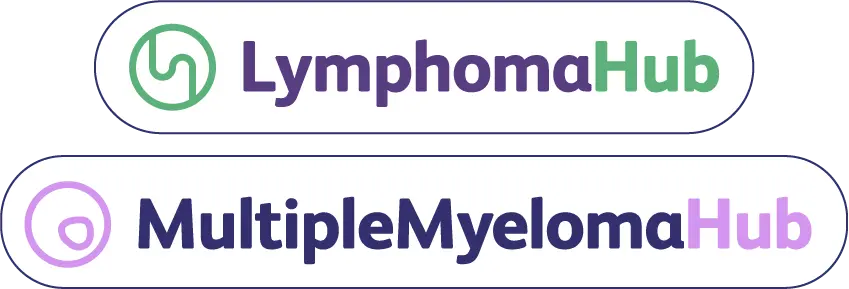All content on this site is intended for healthcare professionals only. By acknowledging this message and accessing the information on this website you are confirming that you are a Healthcare Professional. If you are a patient or carer, please visit the International Myeloma Foundation or HealthTree for Multiple Myeloma.
The Multiple Myeloma Hub uses cookies on this website. They help us give you the best online experience. By continuing to use our website without changing your cookie settings, you agree to our use of cookies in accordance with our updated Cookie Policy
An expert panel hosted by

Sequencing immune-based therapies in B-cell malignancies
with Ulric Jäger, Sagar Lonial, and Krina Patel

Saturday, June 15 | 18:00-19:30 CEST
Register nowThis independent education activity is sponsored by Bristol Myers Squibb. All content is developed independently by the faculty. Funders are allowed no direct influence on the content of this activity.
The Multiple Myeloma Hub website uses a third-party service provided by Google that dynamically translates web content. Translations are machine generated, so may not be an exact or complete translation, and the Multiple Myeloma Hub cannot guarantee the accuracy of translated content. The Multiple Myeloma Hub and its employees will not be liable for any direct, indirect, or consequential damages (even if foreseeable) resulting from use of the Google Translate feature. For further support with Google Translate, visit Google Translate Help.
MagnetisMM-3 trial: Patient-reported outcomes following treatment with elranatamab
Bookmark this article
Patients with multiple myeloma (MM) often experience symptoms which significantly impact their quality of life (QoL), including pain, fatigue, and nausea as well as adverse effects from commonly used treatments. In later lines of therapy, QoL tends to further deteriorate, highlighting maintenance or improvement of QoL as a key goal for therapy.1
Here, we summarize a publication by Mohty et al.1 in the British Journal of Haematology on patient-reported outcomes (PROs) following treatment with elranatamab for relapsed/refractory (RR)MM in the phase II MagnetisMM-3 clinical trial.
The Multiple Myeloma Hub has previously provided coverage of the MagnetisMM trials.
Study design1
- MagnetisMM-3 is a phase II clinical trial investigating elranatamab as a monotherapy in RRMM refractory to ≥ one proteasome inhibitor, immunomodulatory agent, and anti-CD38 monoclonal antibody.
- Patients were administered 76 mg elranatamab subcutaneously once a week from Day 8, with 12 mg and 32 mg step-up doses on Day 1 and Day 4, respectively.
- The primary endpoint of this trial was the overall response rate.
- This analysis measured PROs in patients based on whether they were B-cell maturation antigen (BCMA)-naïve or BCMA-exposed.
- Myeloma-specific questionnaires were used to gather data on global health status, functioning, and symptom change.
Key findings1
- A total of 187 patients were included in this analysis
- BCMA-naïve patients; n = 123
- BCMA-exposed patients; n = 64
- Overall, there was an improvement observed in PROs, regardless of whether patients were BCMA-exposed or -naïve.
- Improvements tended to occur early, with the most common onset at cycle (C) 2, (Day 15 and maintained through C12 Day 1 with some transient fluctuation throughout (Figure 1A and 1B).
- By C1 Day 15, 40.2% of the BCMA-naïve and 52.6% of the BCMA-exposed cohort reported their symptoms to be a ‘little’ or ‘much’ better.
- Amongst BCMA-naïve patients, the observed reduction in pain score was significant, and maintained through C12 Day 1.
- In the BCMA-exposed cohort, pain scores were observed to reduce by C3 Day 15 through C5 Day 1.
- After C5 Day 1, pain scores returned to baseline and fluctuated around the baseline value.
- Amongst BCMA-exposed patients the change in global health status score was largely maintained throughout treatment with the largest decrease observed at C1 Day 15 (−2.0; 95% confidence interval [CI], −8.0 to 4.0) and the largest improvement at C12 Day 1 (9.9; 95% CI, −7.6 to 27.3).
- Data from the myeloma-specific questionnaire showed that both cohorts experienced an improvement in disease symptoms.
- BCMA-naïve patients experienced a significant improvement between C5D1 and C12 Day 1; change from baseline to C5 Day 1 (−6.9; 95% CI, −10.6 to −3.1]).
- The improvement observed in BCMA-exposed patients was not significant overall but was significant at certain time points, in particular from baseline to C2 Day 1 (−9.9; 95% CI, −17.4 to −2.4), which was maintained through C12 Day 1.
Figure 1. Change in symptoms reported in A BCMA-naïve and B BCMA-exposed patients treated with elranatamab over time*

C, cycle; D, day.
*Adapted from Mohty, et al.1
|
Key learnings1 |
|---|
|
- Mohty M, Bahlis N, Nooka A, et al. Impact of elranatamab on quality of life: Patient-reported outcomes from MagnetisMM-3. Br J Haematol. 2024. Online ahead of print. DOI: 1111/bjh.19346
Related articles
Newsletter
Subscribe to get the best content related to multiple myeloma delivered to your inbox






